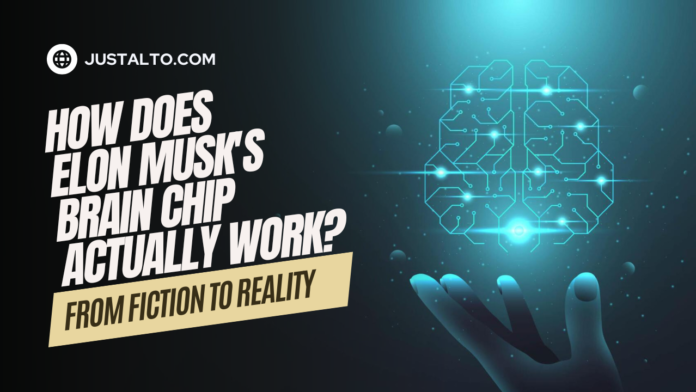Table of contents
- The N1 Implant: Tiny Marvel, Mighty Mission
- Precision Dance: Where Robots Meet the Brain
- Cracking the Neural Code: Decoding the Language of Thought
- From Lab to Life: Bridging the Gap for Medical Miracles
- Beyond Neuralink: A Diverse Symphony of Brain-Machine Interfaces
- Ethical Crossroads: Balancing Progress with Privacy
- Conclusion: Navigating the Neural Frontier
In the ever-evolving tapestry of technological marvels, Elon Musk’s Neuralink stands out as a bold thread seeking to weave a connection between the human mind and robots. The brain chip, known as the N1 implant, promises to bridge the gap, establishing a direct link between our thoughts and external equipment. But before we go deep into this futuristic vision, let’s peel back the layers and explore the nuances of this breakthrough technology.
Imagine your brain as a crowded party: Neurons, the guests, engage in talks, building complicated connections like the active exchanges between individuals. Neuralink intends to be the party decoder, decoding this neuronal dance and maybe even influencing it.
The N1 Implant: Tiny Marvel, Mighty Mission
At the core of Neuralink lies the N1 implant, a wonder of miniaturization around the size of a small coin, not quite a quarter. This small colossus contains threads thinner than a human hair, each fitted with hundreds of microscopic electrodes. Think of them as tiny microphones discreetly eavesdropping on the neuronal interactions. The acquired data is then wirelessly transferred via Bluetooth, making the implant almost unnoticeable following a thorough surgical placement.
Precision Dance: Where Robots Meet the Brain
Installing the N1 implant is no walk in the park. It involves a precise ballet of robotic arms and human competence. Think of it as keyhole surgery on a small scale. The robotic arms, with their unchanging precision, delicately implant the electrodes into the brain, navigating a landscape intricate and delicate beyond human capability. Every stage needs painstaking attention, managing threads smaller than red blood cells with the utmost precision.
Cracking the Neural Code: Decoding the Language of Thought
The N1 implant’s genuine power lies in its capacity to listen in on the brain’s internal chatter. It focuses on “action potentials,” small electrical spikes that neurons utilize to communicate. By capturing and analyzing these spikes, Neuralink intends to crack the neural code, gleaning insights into a user’s thoughts and intents. Imagine learning a new language, but this time, the language is the brain’s own.
From Lab to Life: Bridging the Gap for Medical Miracles
Neuralink’s human trials have a laudable mission: to empower persons with severe motor deficits like quadriplegia caused by spinal cord injuries or ALS. By intercepting brain signals struggling to reach their intended destination, Neuralink tries to restore functionality. Imagine a disabled someone recovering the capacity to control a computer or phone, returning a portion of their independence. This constitutes a huge leap forward in neurotechnology, containing the potential to revolutionize lives.
Beyond Neuralink: A Diverse Symphony of Brain-Machine Interfaces
While Neuralink is a key player, it’s not the only one composing the song of brain-machine interfaces. Numerous researchers and companies are conducting human experiments, exploring various techniques to bridge the gap between mind and machine. This collaborative spirit underlines a shared goal: to enhance neurotechnology for the benefit of humanity.
Ethical Crossroads: Balancing Progress with Privacy
As we journey into the unexplored domain of brain-machine interfacing, ethical questions loom big. Neuralink’s capacity to record brain activity raises issues about privacy and security. Imagine someone getting illegal access to your thoughts! Additionally, the line between treating medical illnesses and upgrading healthy brains for non-medical purposes provokes significant arguments. We must tread carefully, ensuring ethical values govern the development and implementation of this powerful technology.
Conclusion: Navigating the Neural Frontier
Elon Musk’s Neuralink brain chip represents a huge breakthrough towards uncovering the secrets of the human brain. The N1 implant’s tiny wonder, spike-detecting power, and ongoing human trials create a promising picture for the future of neurotechnology. However, traversing this route demands careful thinking. We must address ethical concerns, assure responsible development, and create open discourse to ensure this technology serves humanity’s best interests. The future beckons, a potential merger of man and machine on the horizon. Neuralink remains at the forefront, but the trip ahead demands a community effort, driven by wisdom and accountability, to guarantee this brave new future benefits everybody.

